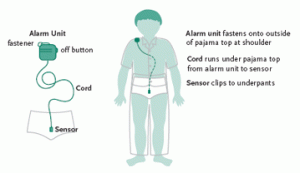
Though many children simply grow out of wetting the bed, some do require treatment in order to resolve the issue. bedwetting treatment includes a number of strategies, ranging from behavior modification to medication. Here are some of the most common forms of bedwetting treatment.
Self-Care Bedwetting Treatment
Before you try anything else, you and your child may want to institute these at-home lifestyle changes as bedwetting treatment.
- Monitor fluid intake. After about 5 PM, limit the amount of fluids your child drinks. Don’t allow him to become dehydrated, but be careful not to let him drink excessively. Be sure that he especially stays away from drinks containing caffeine, like coffee, tea, cola, and hot chocolate, as caffeine will increase urine production and make bedwetting more likely.
- Work on bathroom habits. Encourage your child to use the toilet just before going to sleep, to decrease the likelihood of wetting the bed. However, you should also work to establish good habits throughout the day. Help your child develop a routine of going to the bathroom regularly, so that he learns to recognize his body’s signs that he needs to urinate. This is a major step in bedwetting treatment.
- Designate a clear path to the bathroom. To make it easy for your child to reach the toilet when he gets up in the middle of the night, light the way from his bed to the bathroom, so he doesn’t get lost or confused.
- Reward good behaviors. As your child develops good habits, like visiting the bathroom frequently during the day, be sure to reward him for his hard work. You may also want to establish a sticker chart that allows him to track the nights he is dry. This is a way of keeping track of his progress through his bedwetting treatment
For many children, these methods of at-home bedwetting treatment are very effective at eliminating bedwetting. Be sure to try these tips before moving into any other bedwetting treatment options.
Bedwetting Alarms
If your child is still wetting the bed despite consistently taking the steps listed above, the next level of treatment is using a bedwetting alarm. A bedwetting alarm consists of a sensor in the child’s pajamas that is attached to an alarm. When the sensor detects moisture, the alarm sounds. The child awakens (or is awoken by a parents) and goes to the bathroom to finish urinating. Eventually, the child learns to get up on his own when he needs to urinate. Here are a few things to remember about bedwetting alarms:
- Though these alarms are a very effective method of bedwetting treatment, they will not cure your child overnight, and it may take a few weeks before he will even get out of bed on his own when the alarm sounds. You may have to help wake him up, at first.
- At first, your child may not be able to make it to the bathroom to finish urinating, and he may still wet the bed. Bedwetting treatment is a process, and he needs to develop these skills slowly, even with the help of a bedwetting alarm.
- For a bedwetting alarm to be an effective method of treatment, your child has to be committed to it. If he doesn’t really want to use the alarm and is resisting getting up when it sounds, it won’t be an effective bedwetting treatment.
Medication for Bedwetting Treatment
If both behavioral changes and a bedwetting alarm aren’t helping your child, you may want to consider medication as a form of bedwetting treatment. Three major medications are available:
- Desmopressin. Desmopressin is a synthetic version of a hormone that helps the body produce less urine at night. In children who do not produce enough of this hormone, desmopressin can help regulate the body’s urine production. Children who stop taking desmopressin sometimes begin wetting the bed again within six months, necessitating another form of bedwetting treatment. However, if you need a temporary bedwetting treatment, rather than a long-term solution, desmopressin may be a good option.
- Tofranil. This tricyclic antidepressant can cure bedwetting in children. It relaxes the bladder and allowing it to hold more urine, and it changes the child’s sleep pattern. The drug has a high success rate as a bedwetting treatment, and generally its side effects are mild.
- Anticholinergics. This type of drug reduces bladder contractions and increases bladder capacity. For children whose bedwetting is due to a small bladder, these drugs are very effective as a bedwetting treatment.
No matter which treatment you, your child, and your pediatrician choose, be aware that it could take a few weeks, or even months, before your child stops wetting the bed altogether. This can seem frustrating, but it is just part of retraining the body through treatment to know how to get up in the night to use the toilet. Talk to your pediatrician about which of these bedwetting cures is best for your child.
